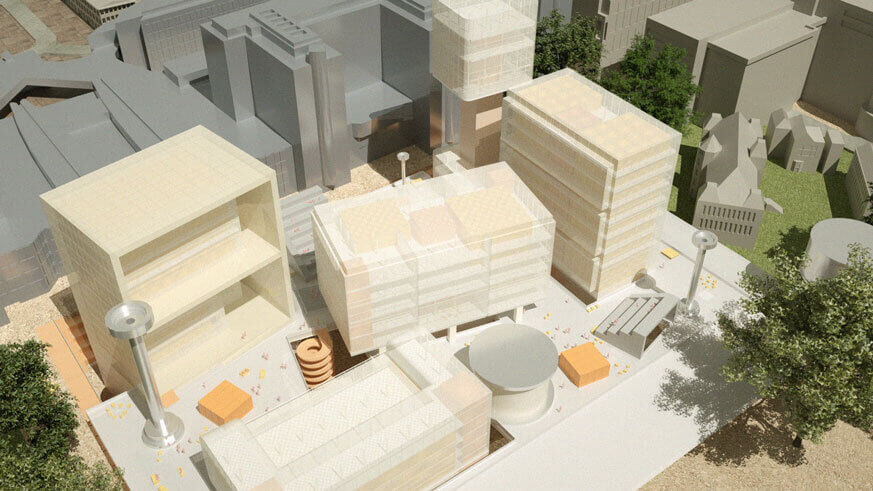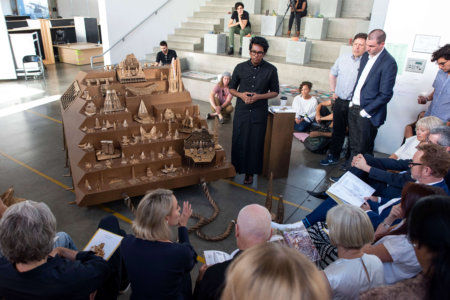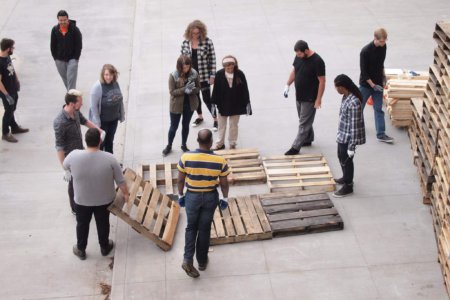Entering the intricate, multidisciplinary field of architecture takes grit. However, with the right application-based education, passion is sufficient. Just ask students at the Southern California Institute of Architecture (SCI-Arc). Here, teaching practices are innovated regularly to ensure students succeed in both an institutional setting and professional practice.
Every SCI-Arc graduate is ready to add value to organisations of all sorts — each with a rough or clear idea of how they will change the world. Another thing they have in common? Endless gratitude to SCI-Arc’s pedagogy for transforming them into the architectural experts they’ve always wanted to be.
As Graduate Programmes Chair, Elena Manferdini plays a crucial role in their development. And while she now has many awards to her name, she can still remember what it felt like to walk in the shoes of the students she now nurtures. She left Italy 23 years ago to discover an even mix of architectural and academic excellence in Los Angeles, California. Just five years later, she began her role as an educator at SCI-Arc.
Over the years, she’s witnessed rapid-fire shifts in the field. The way the institute has adapted to each is the reason why she’s stayed and will continue to do so for as long as she can.
“Digital tools have completely invaded the field of architecture,” she explains. “It has completely changed the mindset of students and how they approach creation. Here, we are staying prepared by bending, embracing, and remaining at the forefront of technological advancement to actually shape how these tools will be used by tomorrow’s architects.”
Convenience isn’t the only thing these shifts bring. As our world digitally progresses; equity, inclusion and sustainability are becoming increasingly topical subjects that cannot be ignored. Hence why active engagement with the world at large is heavily emphasised in SCI-Arc’s pedagogy. “Our students are an investment for the future,” Manferdini says. “As a school, we take all the issues we need to be a part of very seriously.”

Graduate Programmes Chair, Elena Manferdini may have many architectural awards to her name but she still remembers what it felt like to walk in the shoes of the students she now nurtures. Source: SCI-Arc
Hundreds of learners from over 46 different countries are currently in Los Angeles –– a city Manferdini describes as “a generous place for architects” –– learning all about how they can make a difference. While the city is certainly packed with architectural inspiration and known for being a creative cultural hub, it is also filled with areas –– such as downtown –– where SCI-Arc students are welcomed to make a change. Many already have.
“For instance, students have addressed homelessness in collaboration with the mayor of Los Angeles; they’ve been exposed to social housing challenges –– which has been a major issue in the city; and they’ve also designed, handled permits, and built homes for Habitat for Humanity,” says Manferdini. “So there are many opportunities in our curricula for students to go beyond the walls of academia.”
The emphasis on equity translates into accessibility for students as well. Over the years SCI-Arc has only added to its financial support offerings. The full list can be found here. Each was set in place to further improve the inclusivity of the school while ensuring every architectural aspirant gets the support they deserve.
The institution has also improved processes in moving quickly and staying ahead of the field’s developments. Each discovery is immediately adapted into existing curricula. SCI-Arc’s reputation as one of the few –– and definitely the most dynamic –– architectural universities in the US gives it the freedom to collaborate with various informative stakeholders. “It’s a great advantage,” Manferdini says.

At SCI-Arc, emergent techniques in architectural education are formed regularly to bridge the gap between the institutional setting and working practice. Source: Corie Yaguchi / SCI-Arc
SCI-Arc faculty members unpack just as much industry insights during classroom or studio lessons. After all, a majority of them are field-leading practitioners themselves. In 2004, Manferdini founded Atelier Manferdini in Venice, CA where she maintains her role as principal.
“Anybody I hire in my office comes from SCI-Arc,” she enthuses. “From interns to young designers to midlife designers –– everybody in my office has been trained by me in a SCI-Arc classroom or studio.”
Others go on to achieve outstanding outcomes on their own terms. For example, when asked to share one of her favourite student success stories, the first that comes to Manferdini’s mind is Liz and Kyle Von Hasseln’s.
As students, they joined a robotics and 3D printing studio, hoping to apply the technology to industrial and product design for their thesis (which eventually won the 2012 Gehry Prize). Then, they opted to try making a cake topping in white, crystalline sugar.
The result? The formation of The Sugar Lab, which designs and 3D prints edible, “bespoke confections” in sugar, sweet and sour candy, and milk chocolate. It may sound simple but their confections are truly abstract geometric designs. Printing company 3D systems knew this when they acquired The Sugar Lab and kept the Von Hasseln’s on as creative directors. “They made a killing,” Manferdini shares with pride.
“Other students are now faculty, chairs, or deans at other universities. Some develop their own businesses. The rest can be found in some of the best design offices in the world.”
Interested in throwing yourself into the mix? Two pathways serve as golden tickets into the collective SCI-Arc graduate-level experience: The M.Arch 1 and M.Arch 2 –– both of which are accredited by the National Architectural Accrediting Board (NAAB), allowing graduates to pursue architectural licensure for professional practice.
To take your pick and learn more about the dynamic architectural institution that is SCI-Arc, click here.
Follow SCI-Arc on YouTube, Instagram, Facebook, and Twitter.













